yogabook / asanas / ardha padmasana
Contents
ardha padmasana
„half lotus“
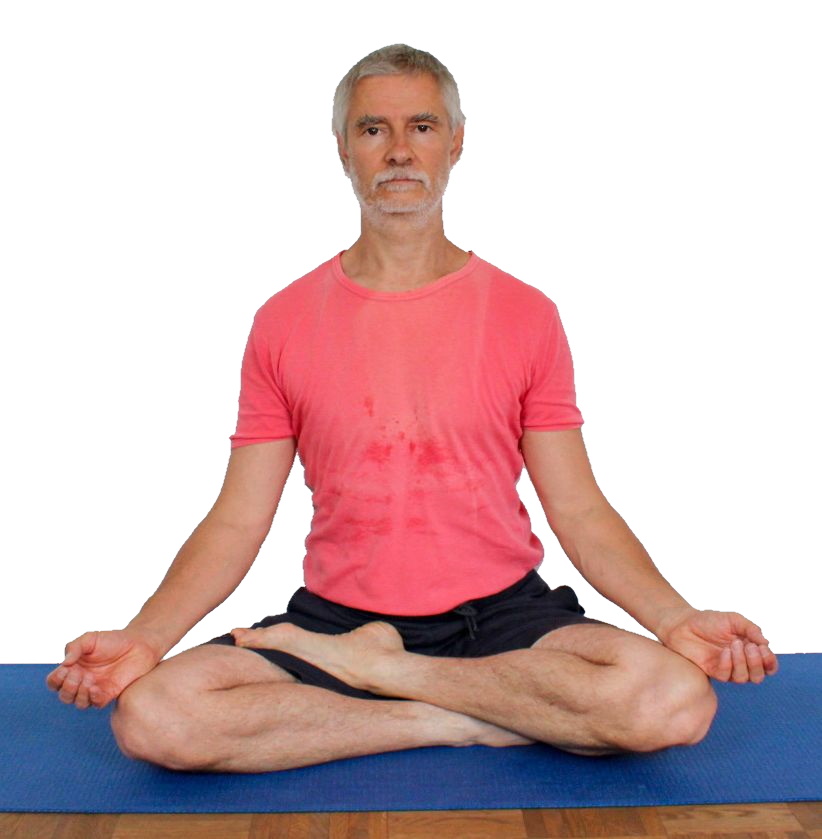
 instructions an details with working links as PDF for download/print
instructions an details with working links as PDF for download/print
detail images
Turn out first leg…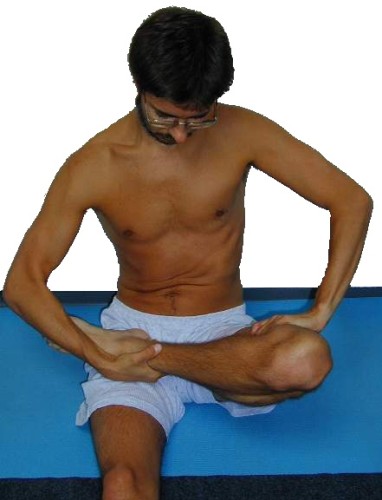 | … then turn out the second leg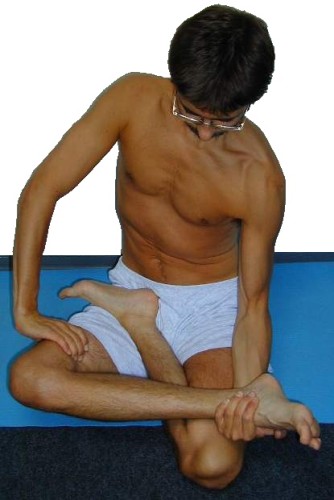 |
Feedback: We’d love to hear what you think about this description, give us feedback at:
postmeister@yogabook.org
Last modified: 30.12.2018
Name: ardha padmasana
Trivial name: half lotus
Level: FA
- classification
- contraindications
- effects
- preparation
- follow-up
- derived asanas
- similar asanas
- diagnostics
- instructions
- details
- variants
Classification
classic: sitting / meditation pose
Contraindication
In the case of disc hernias (herniated and bulging discs) in the lumbar spine, this pose can easily lead to the symptoms flaring up again if due to restricted flexibility of the glutes the lumbar spine loses its physiological lordosis in direction of kyphosis. The forward bend variant in particular is then contraindicated.
Effects
Preparation
In this pose, the capacility to abduct the thighs in the hip joint is less required than the capability to turn them out. Practice for the latter:
- baddha konasana
- supta baddha konasana
- adho mukha supta baddha konasana
- hip opener at the edge of the mat
- hip opener 3
- warrior 2 pose
- parsvakonasana
- counter
In the „forward bend“ variation, this pose is one of the most important for promoting the flexibility of the gluteus maximus and all other short extensors of the hip joint. This flexibility is also needed in the upright pose, so that the pelvis does not tilt backwards, albeit much less than in the forebend. Promote it with:
If there is an increased tendency to cramp in the sole of the foot, prepare plantarflexion with:
- baddha padasana, probably the most precise exercise for plantar flexion in the ankle joint
- virasana does this if attention is paid to the extension of the ankle joint
- supta virasana is slightly less effective than virasana and, of course, especially if you pay attention to the extension of the ankle, but has other, greater challenges.
Apart from this, the tension in the intrinsic foot muscles can also be too high. To counteract this, it helps to stand on a small-diameter fascia roller with a lot of weight.
If the knees remain well away from the floor in the upright ardha padmasana, the situation in the forward bend will be a little better, but it basically requires preparation for the adductors. Those without the knee joint extended are favorable because that the gracilis is bypassed.
- baddha konasana
- supta baddha konasana
- adho mukha supta baddha konasana
- warrior 2 pose
- parsvakonasana
- counter
- caturkonasana
Follow-up
Derived asanas:
Similar asanas:
Diagnostics (No.)
In this position, knee problems associated with wide flexion under load are revealed very well. These can be, for example: traumatic or degenerative meniscus damage, arthrosis, retropatellar events such as chondropathia patellae or retropatellar arthrosis/osteoarthritis, arthritis, subluxations, ligament damage, plica syndromes and others, see the FAQ.
Especially the widely turned out, abducted poses and movements trigger pain in existing hip damage:
- Arthrotic/osteoarthritis changes (degenerative with cartilage atrophy) of the joint
- Arthritis (joint inflammation) of various kinds
- Perthes‘ disease in children, or hip dysplasia in general, can react strongly to this pose
- Dislocation / subluxation, which would cause a significantly increased feeling of tension in various muscles spanning the hip joint
- Joint trauma suffered, which may cause pain in the joint even after many weeks or months
(911) Muscles of the sole of the foot:
In this pose, the sole of the foot is compressed. The perceived tension indicates incorrect loading, also due to inadequate footwear, overloading or deformities of the foot.
In this pose, the adductors are stretched. This can be used to detect damage to them:
- Shortening.
- Irritation of the tendons at the origins and attachments, which manifests itself in pulling pain with a radiation. These may be insertional tendinopathies, e.g. gracilis syndrome, which does not live up to its name here however, as the other adductor muscles coming from the pubic bone are affected rather than the gracilis due to the bent knee joint.
- Tension that causes an agonizing feeling in the muscles that goes far beyond normal stretching.
- Tears/partial tears of adductor muscles, which, in the event of tears, impress with a loud noise when happening, possibly followed by hematoma formation and swelling.
- Side discrepancies in flexibility, which can cause a pelvic obliquity and consecutive scoliosis, see the FAQ and the asu guides to baddha konasana on the wall.
Variants:
Instruction
- Sit cross-legged.
- Grasp the left foot with the right hand, grasp the left inner thigh near the knee with the left hand and turn it out as far as possible.
- Place this leg on the floor, bending your right knee as far as possible.
- Grasp the right inner thigh close to the knee with the right hand and turn it out as far as possible.
- Grasp the right foot with the left hand and place it on the left thigh as close to the pelvis as possible, bending the right knee as much as possible.
Details
- As in all comparable poses such as padmasana, sukhasana and siddhasana, this is also a not unproblematic situation for the knee joint if the hip joint can not be turned out well. Varus stress and internal rotation of the lower leg in the knee joint place strain on the medial meniscus. Of course, this must not hurt during and after the exercise. If it is clearly painful and it is not possible to stop the pain with the following tricks (for additional tricks see also the FAQ), it is not the right time to practise ardha padmasana:
- Turn the right leg out even more forcefully and, if necessary, use the right hand to hold the thigh turned out during the entire execution of the pose.
- Support the right knee with a suitable aid, e.g. a block or mat or a combination of these.
- Practice the 3rd hip opening before ardha padmasana, 1 or 2 rounds per side.
- Sometimes the outer edge of the foot belonging to the lower leg presses uncomfortably on the floor when there is still little opportunity to turn the thighs out in the hip joints and when the knees are raised. This can usually be alleviated by padding with a blanket.
- Likewise, if there is little flexibility in terms of external rotation in the hip joint, the foot of the upper leg can be forced very strongly into supination, which is felt as intense pain in the outer ankle area. Then place the foot of the upper leg between the thigh and lower leg of the first leg or, even more simply, in front of the lower leg. In particular, if a fibularis tertius or another dorsiflexing variety of the fibularis group is present, an intensive stretch can be felt in this group due to the pronounced supination.
- To sit upright, it is very helpful to start by pulling both buttocks backwards and outwards.
- Sitting on cold floors can lead to irritation of the sciatic nerve if you are predisposed to this. Therefore, sit on a warm floor or a warming surface or cushion with materials that do not conduct heat well.
- Sitting on too soft a surface offers too little resistance and tends to cause the pelvis to tilt backwards, which is probably one of the difficulties experienced by less mobile performers anyway. Furthermore, surfaces that are too soft lead to an unfavorable distribution of pressure away from the ischial tuberosities towards the surrounding tissue, which can also irritate the sciatic nerve in some cases.
- If the pelvis tends to tilt backwards too much, sit with the „posterior edge of the buttocks“ on an appropriate support. It is used correctly when you almost feel as if you are slipping forward off the support.
Known problems that can occur even when used correctly
Pain in the inner knee
Despite correct execution and vigorous turning of the legs, pain can occur in the inner knee, particularly in the upper leg, if the inner meniscus is damaged. Tricks for dealing with this type of knee pain can be found in the FAQ.
Pressure between the lower legs
Uncomfortable pressure between the lower legs can occur in the pose – but less than in full lotus. This should disappear with increasing flexibility.
Variants
Forward bend

Detailed photos

Effects:
(726) Stretching the short/monoarticular hip extensors
Instructions
- Take the pose as described above, pull both buttocks backwards and outwards.
- Straighten the back again and bend forward from the hip joints.
- If possible, rest your forehead on the floor and stretch your arms forward away from your body.
Details
- This is a standard pose for stretching shortened or tense glutes.
- If there is a tendency towards discomfort in one or both knees in the basic pose, this will usually increase in the forward bend, as the flexion in the hip joints pulls the origin of most of the adductors towards the floor and therefore further away from the base, which turns the thigh in and leads to increased compression in the inner knee. Counteract this with the tricks described in the FAQ.
Known problems that can occur even when performed correctly
The pressure between the lower legs described in the basic pose tends to be more pronounced in the forward bend.
Ankle not on thigh

Detailed photos
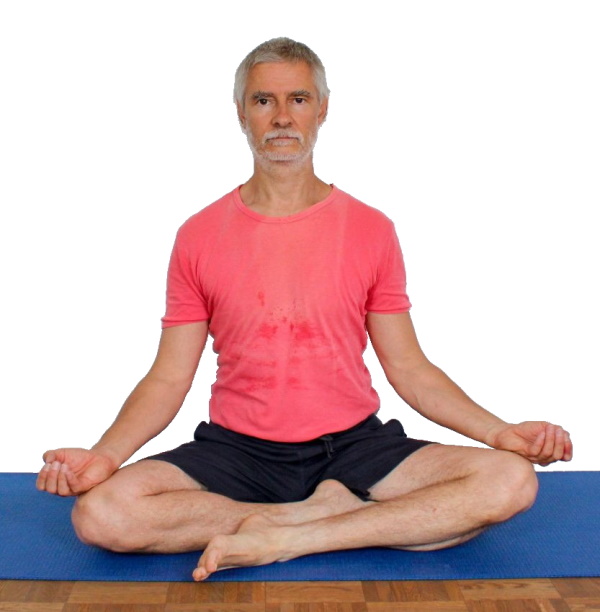
Instruction
- Take the pose of the first leg as described above, then turn out the second leg well, but do not place the foot on the first thigh, instead place it on the floor in front of the other lower leg.
Details
- This variation requires less capability to turn out the thigh in the hip joints and reduces the tendency to knee pain when performing the pose, if the knees are already damaged. As an intermediate stage between this variation and the basic pose described above, the second foot can also be placed between the first thigh and lower leg. In both cases, the relief is based on the fact that the foot is less high in relation to the knee, which corresponds to a lower degree of external rotation of the thigh in the knee joint as well as a less flexed knee koint.
with a block under the knee

Instructions
- Take the pose as described above.
- Place a block close to your knee under the thigh whose knee hurts. If the pain does not subside or does not subside significantly enough, move the block towards the pelvis or use a higher elevation.
Details
- This is one of the standard measures described in the FAQ to reduce or eliminate knee pain in similar poses. It is based on a reduced demand on the capability to turn out the thigh in the hip joint and also on reduced varus stress.
with weights
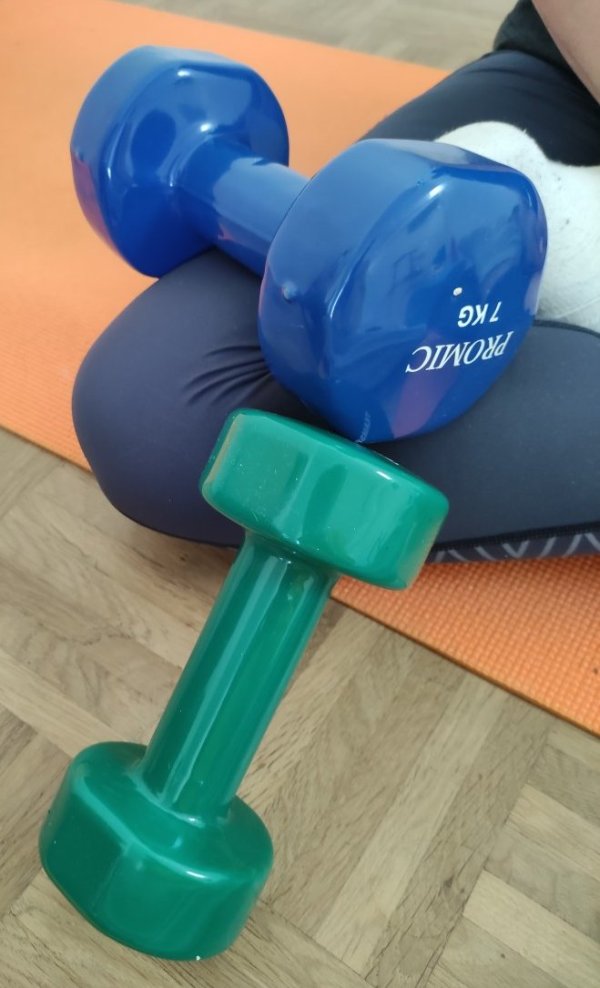
Instructions
- Place a dumbbell on one thigh close to your knee. If the dumbbell threatens to fall off the leg, support the dumbbell with another dumbbell placed diagonally against the first dumbbell. This can be done with both legs.
Details
- If you have problems with your inner knee, the barbell can make the situation worse, especially if you have meniscus problems. It will then be even more important to carefully turn out both thighs in the hip joint when setting up the posture. It can also be helpful to place the supporting dumbbell on the outer side of the thigh and allow the first dumbbell to tilt slightly towards the floor, creating a small inner knee-relieving externally rotating torque in the hip joint.
- Depending on the support used, its edge can press uncomfortably on the outer thigh, in particular the pressure on the vastus lateralis and even more on the tractus iliotibialis can be quite unpleasant. Therefore, a soft medium should be placed in between if necessary.
